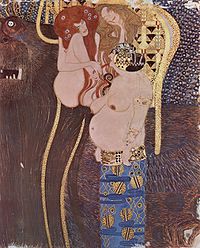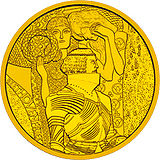
Beethoven Frieze
Encyclopedia

Gustav Klimt
Gustav Klimt was an Austrian Symbolist painter and one of the most prominent members of the Vienna Secession movement. His major works include paintings, murals, sketches, and other art objects...
.
Description
In 1902, Klimt painted the Beethoven Frieze for the 14th Vienna SecessionVienna Secession
The Vienna Secession was formed in 1897 by a group of Austrian artists who had resigned from the Association of Austrian Artists, housed in the Vienna Künstlerhaus. This movement included painters, sculptors, and architects...
ist exhibition, which was intended to be a celebration of the composer
Ludwig van Beethoven
Ludwig van Beethoven was a German composer and pianist. A crucial figure in the transition between the Classical and Romantic eras in Western art music, he remains one of the most famous and influential composers of all time.Born in Bonn, then the capital of the Electorate of Cologne and part of...
and featured a monumental polychrome sculpture by Max Klinger
Max Klinger
Max Klinger was a German Symbolist painter, sculptor, printmaker, and writer.Klinger was born in Leipzig and studied in Karlsruhe. An admirer of the etchings of Menzel and Goya, he shortly became a skilled and imaginative engraver in his own right. He began creating sculptures in the early 1880s...
. Meant for the exhibition only, the frieze
Frieze
thumb|267px|Frieze of the [[Tower of the Winds]], AthensIn architecture the frieze is the wide central section part of an entablature and may be plain in the Ionic or Doric order, or decorated with bas-reliefs. Even when neither columns nor pilasters are expressed, on an astylar wall it lies upon...
was painted directly on the walls with light materials. After the exhibition the painting was preserved, although it did not go on display again until 1986. The Beethoven Frieze is now on permanent display in the Vienna Secession Building
Secession hall (Austria)
The Secession building is an exhibition hall built in 1897 by Joseph Maria Olbrich as an architectural manifesto for the Vienna Secession, located in Vienna, Austria...
.
Trivia
Because of the frieze's fame and popularity, it was made the main motif of one of the most famous collectors' coins: the Austrian 100 euro The Secession Coin, minted on November 10, 2004. The reverse side features a small portion of the frieze. The extract from the painting features three figures: a knight in armor representing “Armored Strength”, one woman in the background symbolizing “Ambition” holding up a wreath of victory and a second woman representing “Sympathy” with lowered head and clasped hands.

